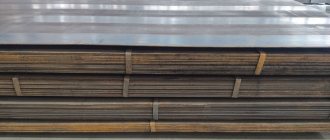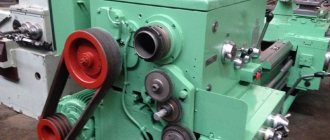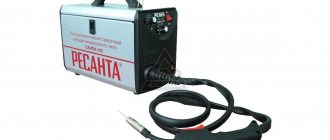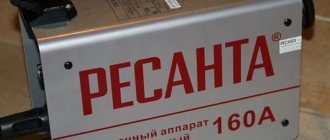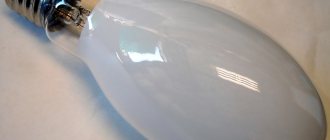Decoding 09G2S
The marking of steel 09G2S indicates the chemical composition of the alloy:
- carbon fraction in the alloy - 09;
- fluctuation in the share of manganese 2% in the total volume of G2;
- share of silicon up to 1% - C.
Additional components are added to the 09G2S alloy: sulfur, chromium, phosphorus, nickel, copper, aluminum, and nitrogen. They are not indicated in the labeling, because the share does not exceed 1% of the alloy volume. The marking of steel does not always correspond to the chemical composition; steel is marked according to its structure, purpose, manufacturing methods, and chemical properties. Sometimes there is confusion in the markings, for example, 09G2S is confused with steel 354. However, 345 is a fluidity marker that has nothing to do with the chemical composition; steel with this marking is intended for use in construction.
Calculation of the hardness value in the heat-affected zone
The next parameter to pay attention to is the hardness of the heat-affected zone (HAZ). This is the name given to the section of the product that is located near the formed seam. In this region, under the influence of temperature, phase transformations occur with a change in the internal structure of the metal. Sometimes this can lead to the steel becoming brittle.
The hardness of the metal in this zone is determined using the Vickers method. If its values are in the range of 350-400 on a special HV scale, then in the HAZ area there are definitely decomposition products of austenite (one of the modifications of iron and its alloys), which initiate the formation of cold cracks.
The maximum hardness value of carbon and low-alloy steel is calculated using data on the chemical composition of the metal using this formula:
where C, Mn, Si, Cr, Ni are mass fractions (in percent) of chemical elements.
Advantages and disadvantages of 09G2S
The only drawback of 09G2S steel is its instability to rust. There are many more advantages:
- strength;
- duration of service life under normal conditions (more than 30 years);
- heat resistance does not lose shape at temperatures from about -70 to 425C;
- no temper fragility;
- good weldability;
- low cost;
- high resistance to mechanical stress;
- undemanding processing.
Susceptibility to rust limits the scope of use of products made from 09G2S steel, but its advantages over other alloys make it the most popular and widespread.
Application of steel 09G2S
The material is successfully used for the manufacture of wear-resistant building products. These are channels, load-bearing beams, fencing corners and other products. In other industries, indicators such as the temperature range of steel stability are in demand. For example, laying a pipeline in the north of Russia imposes certain requirements on the material used to make pipes. Resistance to low temperatures down to -70 and efficiency of 09G2S steel is an ideal combination for laying communications that are costly in terms of quantity of material and exposed to low temperatures, including pipelines. 09G2S steel is popular in the automotive industry and in the chemical industry due to its resistance to chemical and biological influences, as well as its high strength of bolt fastening of products.
Designations
| Name | Meaning |
| Designation GOST Cyrillic | 09G2FB |
| Designation GOST Latin | 09G2FB |
| Translit | 09G2FB |
| By chemical elements | 09Mn2VNb |
| Name | Meaning |
| Designation GOST Cyrillic | 09G2BT |
| Designation GOST Latin | 09G2BT |
| Translit | 09G2BT |
| By chemical elements | 09Mn2NbTi |
Features of welding steel 09G2S
Steel 09G2S is easy to weld; this property is ensured by the low carbon content in the alloy. There are no heating requirements; you can cook without preliminary heat treatment; this does not affect the strength of the seam. There are any welding methods and equipment; you can weld with a gas torch or an electric arc under a submerged arc. Steel products do not require hardening before or after welding and do not overheat during welding, so the grain size and ductility of the material do not change. Because 09G2S is a low-alloy low-carbon alloy; when welding it is necessary to use various electrodes for the appropriate purpose.
Characteristics of steel 09G2S
Steel 09G2S can be forged in the temperature range 850-1250C. Depending on heating, steel has a yield strength in the range of 255-155 MPa. Does not lose ductility during welding. In the temperature range of 100-500C, the change in the linear expansion coefficient is 2.4X10-6 units. Operating temperatures range from -70 to +425C.
Supply
| B22 – Long and shaped rolled products | GOST 8281-80; GOST 2591-2006; GOST 26020-83; GOST 8509-93; GOST 8510-86; GOST 8239-89; GOST 8240-97; GOST 8278-83; GOST 8283-93; GOST 2590-2006; GOST 21026-75; GOST 25577-83; GOST 11474-76; GOST 14635-93; GOST 13229-78; GOST 19425-74; GOST 19771-93; GOST 19772-93; GOST 9234-74; GOST 8282-83; |
| B23 - Sheets and strips | GOST 103-2006; GOST 17066-94; GOST 19903-74; GOST 5520-79; GOST 82-70; |
| B33 - Sheets and strips | GOST 19282-73; GOST 10885-85; |
| B62 — Steel pipes and connecting parts for them | GOST 9567-75; GOST 24950-81; GOST 10705-80; GOST 30564-98; GOST 30563-98; GOST 20295-85; GOST 8731-87; GOST 8732-78; GOST 53383-2009; |
Chemical composition
The definition of 09G2S steel as low-alloy means that the content of alloying additives in the chemical composition of the alloy is minimal. As the percentage of an element or additive increases, the steel marking changes. This marking defines 09G2S steel as silicon-manganese, which means that the remaining additives in total do not exceed 1-2% of the total volume of the alloy.
Chemical composition in % of material 09G2S
GOST 19281 - 2014
| C | Si | Mn | Ni | S | P | Cr | V | N | Cu | As |
| up to 0.12 | 0.5 — 0.8 | 1.3 — 1.7 | up to 0.3 | up to 0.035 | up to 0.03 | up to 0.3 | up to 0.12 | up to 0.008 | up to 0.3 | up to 0.08 |
| Note: Steel must be deoxidized Al=0.02-0.06%. Also chem. the composition is specified in GOST 5520 - 79, GOST 19282-73 |
The temperature of the critical points of the material is 09G2S.
| Ac1= 725 , Ac3(Acm) = 860 , Ar3(Arcm) = 780 , Ar1= 625 |
Impact strength
Impact strength shows how a product behaves under shock or dynamic loads and is one of the key technical characteristics of the alloy. It strongly depends on the heating or cooling temperature, so the table shows temperature values.
Impact strength, KCU, J/cm2
| Delivery condition, heat treatment | +20 | -40 | -70 |
| GOST 19281-73. Long and shaped rolled products with a cross section of 5-10 mm. | 64 | 39 | 34 |
| GOST 19281-73. Long and shaped rolled products with a cross section of 10-20 mm. | 59 | 34 | 29 |
| GOST 19281-73. Long and shaped rolled products with a cross-section of 20-100 mm. | 59 | 34 | |
| GOST 19282-73. Sheets and strips with a cross section of 5-10 mm. | 64 | 39 | 34 |
| GOST 19282-73. Sheets and strips with a cross section of 10-160 mm. | 59 | 34 | 29 |
| GOST 19282-73. Sheets after hardening, tempering (Transverse samples) with a cross section of 10-60 mm | 49 | 29 |
Impact strength standards KCV , J/cm 2*
| Strength class | At a temperature of 20 C | At a temperature of 0 C |
| 325 | >34 | >34 |
| 345 | >40 | >40 |
*only for long and shaped steel
Endurance limit
The endurance limit indicator is the value of the maximum pressure in the cycle at which the steel does not fail due to metal fatigue. The number of cyclic loads can be indefinitely large.
| σ-1, MPa | σB, MPa |
| 235 | 475 |
Yield strength of steel 09G2S
The yield strength shows how much stress must be created in order for the steel to continue to deform while maintaining the load. The indicator varies depending on the content of alloying additives and carbon. Silicon and manganese do not affect the fluidity of steel.
| Test temperature, °C / σ0.2 | |||
| 250 | 300 | 350 | 400 |
| 225 | 195 | 175 | 155 |
Hardenability of steel 09G2S
What depth of hardened layer can be obtained by calcining a product? This question is answered by the hardenability indicator. The carbon content in the alloy has the greatest influence on hardenability.
| Distance from the end, mm / HRC e | |||||||||
| 1.3 | 3 | 6 | 9 | 12 | 18 | 24 | 30 | 36 | 42 |
| 52.0 | 52.0 | 51.5 | 49.5 | 48.5 | 45.5 | 44.0 | 43.5 | 43.5 | |
| Critical diameter in water, mm | Critical diameter in oil, mm |
| 70 | 45 |
Technological properties of steel 09G2S
The main technological properties of steel include:
- Weldability determines the quality and strength of welded joints;
- flake sensitivity - the susceptibility of steel to flocs, structural defects caused by high hydrogen content;
- tendency to temper brittleness tendency to decrease impact strength after high tempering with slow cooling.
Technological properties of material 09G2S.
| Weldability: | no limits. |
| Flock Sensitivity: | not sensitive. |
| Tendency to temper brittleness: | not inclined. |
Grade 09G2S - low viscosity, J/cm 2
| Assortment | Size, mm | KCU at temperatures | ||
| -70 oС | -40 oС | +20 oС | ||
| Rental | 5-10 | 34 | 39 | 64 |
| 10-20 | 29 | 34 | 59 | |
| 20-32 | 34 | 59 | ||
| Sheets and strips | 5-10 | 34 | 39 | 64 |
| 10-160 | 29 | 34 | 59 | |
| After quenching and tempering | 10-60 | 29 | 49 | |
Mechanical properties of steel 09G2S
Information about the mechanical properties of steel is indicated for certain temperatures, because metal changes its properties when heated/cooled. These include strength, hardness, ductility, and impact strength.
Mechanical properties at T=20oC of material 09G2S.
| Assortment | Size | Eg. | sв | sT | d5 | y | KCU | Heat treatment |
| — | mm | — | MPa | MPa | % | % | kJ/m2 | — |
| Sheet, GOST 5520-79 | 430-490 | 265-345 | 21 | 590-640 | ||||
| Pipes, GOST 10705-80 | 490 | 343 | 20 | |||||
| Grade, Strength class 265, GOST 19281-2014 | up to 250 | 430 | 265 | 21 |
Mechanical properties at elevated temperatures
| test t, °C | σ0.2, MPa | σB, MPa | δ5, % | ψ, % |
| Normalization 930-950 °C | ||||
| 20 | 300 | 460 | 31 | 63 |
| 300 | 220 | 420 | 25 | 56 |
| 475 | 180 | 360 | 34 | 67 |
Mechanical properties depending on tempering temperature
| holiday t, °С | σ0.2, MPa | σB, MPa | δ5, % | ψ, % |
| Sheets 34 mm thick in delivery condition HB 112-127 (transverse samples) | ||||
| 20 | 295 | 405 | 30 | 66 |
| 100 | 270 | 415 | 29 | 68 |
| 200 | 265 | 430 | ||
| 300 | 220 | 435 | ||
| 400 | 205 | 410 | 27 | 63 |
| 500 | 185 | 315 | 63 | |
Properties according to GOST 14249 standard
| Assortment | Temperature of the wall of a vessel or apparatus, o C | Temporary tensile strength σ B ,MPa (kgf/cm2) | Yield strength for permanent deformation, Re MPa (kgf/cm2) |
| For wall thicknesses up to 32 mm | |||
| Vessel, apparatus | 20 | 470 (4700) | 300 (3000) |
| Vessel, apparatus | 100 | 425 (4250) | 265,5 (2655) |
| Vessel, apparatus | 150 | 430 (4300) | 256,5 (2565) |
| Vessel, apparatus | 200 | 439 (4390) | 247,5 (2475) |
| Vessel, apparatus | 250 | 444 (4440) | 243 (2430) |
| Vessel, apparatus | 300 | 445 (4450) | 226,5 (2265) |
| Vessel, apparatus | 350 | 441 (4410) | 210 (2100) |
| Vessel, apparatus | 375 | 425 (4250) | 199,5 (1995) |
| Vessel, apparatus | 400 | — | 183 (1830) |
| With a wall thickness of more than 32 mm | |||
| Vessel, apparatus | 20 | 440 (4400) | 280 (2800) |
| Vessel, apparatus | 100 | 385 (3850) | 240 (2400) |
| Vessel, apparatus | 150 | 430 (4300) | 231 (2310) |
| Vessel, apparatus | 200 | 439 (4390) | 222 (2220) |
| Vessel, apparatus | 250 | 444 (4440) | 218 (2180) |
| Vessel, apparatus | 300 | 445 (4450) | 201 (2010) |
| Vessel, apparatus | 350 | 441 (4410) | 185 (1850) |
| Vessel, apparatus | 375 | 425 (4250) | 174 (1740) |
| Vessel, apparatus | 400 | — | 158 (1580) |
| Vessel, apparatus | 410 | — | 156 (1560) |
| Vessel, apparatus | 420 | — | 138 (1380) |
Allowable tensile stress, σ, MPa (kgf/cm2) at temperature, o C*
| +20 | +100 | +150 | +200 | +250 | +300 | +350 | +375 | +400 | +410 | +420 | +430 | +440 | +450 | +460 | +470 | +480 |
| For wall thicknesses up to 32 mm | ||||||||||||||||
| 196 (1960) | 177 (1770) | 171 (1710) | 165 (1650) | 162 (1620) | 151 (1510) | 140 (1400) | 133 (1330) | 122 (1220) | 104 (1040) | 92 (920) | 86 (860) | 78 (780) | 71 (710) | 64 (640) | 56 (560) | 53 (530) |
| With a wall thickness of more than 32 mm | ||||||||||||||||
| 183 (1830) | 160 (1600) | 154 (1540) | 148 (1480) | 145 (1450) | 134 1340() | 123 (1230) | 116 (1160) | 105 (1050) | 104 (1040) | 92 (920) | 86 (860) | 78 (780) | 71 (710) | 64 (640) | 56 (560) | 53 (530) |
*At temperatures below +20 oC, the permissible stresses are taken to be the same as at +20 oC, subject to the permissible use of the material at this temperature
Properties according to GOST 10066-94 standard
| Tensile strength σB MPa | Yield strength for permanent deformation, σT MPa | Elongation at break, δ, % |
| Hot rolled steel | ||
| >490 | >345 | >19 |
| Cold rolled steel | ||
| >460 | >345 | >19 |
*for rolled products with a thickness of 0.5-3.9 mm and a width of at least 500 mm
Bending until the sides are parallel for hot-rolled and cold-rolled steel d: = 2a, where a is the thickness of the sample, d is the diameter of the mandrel
Properties according to GOST 32678-2014 standard
| Assortment | Tensile strength σB MPa | Yield strength for permanent deformation, σT MPa* | Elongation at break, δ5, % |
| Heat-treated products | |||
| Pipes | >470 | >265 | >21 |
| Without heat treatment** | |||
| Pipes | >315 | >216 | >5 |
* As agreed between the manufacturer and the customer: tensile strength of at least 441 MPa, yield strength for permanent deformation of at least 245 MPa
**The mechanical properties of pipes without heat treatment are established by agreement between the manufacturer and the consumer. In the absence of such approval, the production of welded cold-deformed pipes must comply with the standards specified in the table.
Physical properties of steel 09G2S
The physical properties of steel include thermal conductivity, heat capacity, elastic modulus, shear modulus, coefficient of linear and volumetric expansion with temperature changes.
Physical properties of material 09G2S.
| T | E 10- 5 | a106 | l | r | C | R 109 |
| hail | MPa | 1/Grad | W/(m deg) | kg/m3 | J/(kg deg) | Ohm m |
| 20 | ||||||
| 100 | 11.4 | |||||
| 200 | 12.2 | |||||
| 300 | 12.6 | |||||
| 400 | 13.2 | |||||
| 500 | 13.8 | |||||
| T | E 10- 5 | a106 | l | r | C | R 109 |
Chemical composition
| Standard | C | S | P | Mn | Cr | Si | Ni | Fe | Cu | N | Al | V | Ti | Nb |
| TU 14-1-3979-85 | 0.08-0.11 | ≤0.006 | ≤0.02 | 1.5-1.7 | — | 0.15-0.35 | — | Remainder | ≤0.3 | — | 0.02-0.05 | 0.05-0.08 | 0.01-0.035 | 0.02-0.04 |
| TU 14-1-3978-85 | ≤0.13 | ≤0.007 | ≤0.02 | ≤1.7 | ≤0.3 | ≤0.35 | ≤0.3 | Remainder | ≤0.3 | ≤0.01 | 0.02-0.05 | ≤0.09 | 0.01-0.03 | ≤0.05 |
| TU 14-3-1573-96 | ≤0.13 | ≤0.007 | ≤0.02 | ≤1.7 | ≤0.3 | ≤0.35 | ≤0.3 | Remainder | ≤0.3 | ≤0.012 | 0.02-0.05 | ≤0.09 | 0.01-0.035 | ≤0.05 |
Fe is the basis. According to TU 14-3-1573-96, the chemical composition is given for steel grade 09G2FB. Carbon equivalent Se ≤ 0.43%. It is allowed to introduce technological additives of silicocalcium or rare earth materials (REM) into steel at the rate of 0.5-2.0 kg per 1 ton of steel. According to TU 14-1-3979-85, the chemical composition is given for steel grade 09G2FB. Calcium or cerium content up to 0.020% is allowed. Steel is treated with synthetic slag, argon, additives of silicocalcium, silicobarium or alloys of rare earth elements (cerium, etc.) in an amount of 1.5-2 kg/t; zirconium can be added up to a content of 0.020%. Residual content of chromium and copper is allowed up to 0.30% each, nitrogen up to 0.010%. In slabs, deviations in chemical composition are allowed: carbon ±0.020%, manganese ±0.10%, silicon ±0.050%, vanadium ±0.020%, niobium -0.010%, sulfur +0.0020%, phosphorus +0.0050%. The carbon equivalent of steel should be no more than 0.43. It is allowed to manufacture 09G2FB steel without vanadium with a mass fraction of titanium of 0.05-0.09%. In this case, the steel is designated 09G2BT. In steel 09G2BT, deviations for titanium of +0.010% are permissible.
Source
Analogs and substitutes for steel 09G2S
The table shows the markings of alloys similar to 09G2S steel on foreign markets. Please note that not all analogues are accurate.
Foreign analogues of the material
Attention! Both exact and closest analogues are indicated.
| Germany | Japan | China | Bulgaria | Hungary | Romania | |||||
| DIN,WNr | JIS | G.B. | BDS | MSZ | STAS | |||||
|
Density of low alloy steels
The density values of the following low-alloy steels are presented: steel 15М, 12МХ, 15ХМ, 15ХФ, 30Х, 30Н3, 30ХН3, 12Х5СМА, Х6М, 30Г2, 50С2Г. The average density of low-alloy steels ranges from 7725 to 7855 kg/m3 at a temperature of 20°C. The data in the table is given depending on temperature - in the range from 0 to 1000°C. The density dimension in the table is kg/m3.
Sources
- https://vse-stali.ru/stal-konstruktsionnaya/nizkolegirovannaya-dlya-svarnyh-konstruktsij/stal-09g2s/
- https://metalloy.ru/stal/stal-09g2s
- https://pressadv.ru/stali/09g2s-harakteristiki.html
- https://svarkaipayka.ru/material/stal/tehnicheskie-harakteristiki-stali-09g2s.html
- https://ScrapTraffic.com/splav/09g2s/
- https://www.manual-steel.ru/09G2S.html
- https://www.lsst.ru/spravochnik-metalloprokata/nizkolegirovannaja-stal/stal-09g2s/
- https://tutsvarka.ru/vidy/legirovannaya-stal-09g2s-harakteristiki-primenenie-tverdost-analogi
- https://www.lsst.ru/spravochnik-metalloprokata/konstruktsionnaya-stal/stal-09g2s/
- https://tpspribor.ru/vidy-metalla/stal-09g2s-harakteristika-primenenie-i-svoystva-stali-09g2s.html
- https://thermalinfo.ru/svojstva-materialov/metally-i-splavy/plotnost-stali-temperaturnaya-zavisimost
[collapse]
Comparison of 09G2S with brand 17G1S
Two popular grades of steel have a similar composition, but differ in a number of characteristics, especially in structure. The martensitic structure of 09G2S steel is optimal for load-bearing structures, therefore 09G2S steel is defined as structural and is widely used in construction. 17G1S is almost never used for the manufacture of load-bearing structures. The increased carbon content in this alloy ensures the formation of a ferritic structure, which, despite its strength, is more suitable and makes it possible to lay underground communications. Therefore, 17G1S steel is used to make pipes for heating networks and industrial engineering systems. It is also inferior in frost resistance, its lower temperature limit is -40C versus -70C for the 09G2S alloy, but is characterized by increased resistance to high temperatures up to +475C versus +425 degrees in the case of 09G2S.
Manufacturing
The basis for the manufacture of the material is cast iron. It goes through a long optimization process, during which the amount of carbon in the composition increases and the basic properties of the metal improve. To achieve certain technical characteristics, additional alloying additives are added.
- Open-hearth method. An industrial furnace is loaded with scrap, cast iron, charge, and additional components. A pile of metal is melted using a torch of burning fuel. Once the scrap is melted, alloying components are added to the bath. When carrying out the procedure, special open-hearth furnaces are used, which can smelt up to 900 tons of metal at a time.
- Electrothermal method. During production, an industrial electric furnace is used, with which you can accurately set the heating mode and control the metal production process. The main advantage of the technology is the ability to obtain metal with the lowest content of harmful impurities (phosphorus, sulfur). Thanks to the ability to set very high heating temperatures, it is possible to obtain specialized types of steel with unique technical characteristics.
- Converter. Molten cast iron is poured into the melting apparatus and purged with oxygen. The impurities contained in the cast iron begin to oxidize. Oxidation releases a large amount of heat, which increases the overall temperature to 1600 °C.
What is the difference between galvanized, stainless and black steel
Speaking about corrosion resistance indicators, stainless steel is preferable to galvanized and black steel; these are different categories of protection. Galvanized steel is protected from corrosion by a thin or thick layer of zinc, and stainless steel is protected by the content of alloying additives in the alloy structure. This is a big difference, because... It is easy to damage the zinc layer, revealing unprotected steel behind it. Stainless steel does not need a protective film; it is protected from the inside by its own chemical properties until the end of its service life; the absence of a coating does not affect it in any way.
Black steel has no protection at all, so it is the most susceptible to corrosion. To increase its service life, it is recommended to coat it with powder paint and process it in a polymerization oven.
By service life
The service life of working parts for each of the steels differs by a factor of two: 50 years for the first versus 25 years for the second and 10 years for the third. And these are average figures, because... Due to damage to the zinc layer, the product will most likely fail earlier. Black steel is the least wear-resistant.
Environmentally friendly
When heated or exposed to acids, zinc releases harmful compounds zinc oxide and phosphides. Poisoning can be of varying strength, including death if the damage is extensive. Stainless steel is completely safe in any product and has proven itself in the production of cookware. Ferrous metal is also not toxic, but due to its susceptibility to corrosion, it is almost always isolated from humans by a protective layer of paint.
By cost
The lower limit of the cost of 1 ton of ordinary stainless steel sheet is 113 thousand rubles. A galvanized hot-rolled sheet of the same weight can be purchased at a price of 67 thousand rubles. The price of the same sheet of black steel starts from 45 thousand rubles. The cost is also influenced by the quality characteristics of the steel and the choice of manufacturers. Read more about this in the materials on our website.
Determination of steel sensitivity to cold cracking
Cold cracks form after welding due to tensile residual stresses. Their strength depends on the rigidity of the resulting structure and the thickness of the seam. Its value can be determined by the stiffness intensity coefficient - K. It characterizes the applied force, which opens the gap by 1 mm, which is also 1 mm wide in the welded joint. It is calculated like this:
where Kq is a constant, which is considered to be equal to 69, S is the thickness of the steel sheet (in mm). It is important to note that the ratio is only valid if the sheet thickness does not exceed 150 mm.
How steel can be susceptible to cold cracking can be determined by the parametric equation:
where Рш is the “embrittlement” coefficient (this is the name for the process when a metal goes from a viscous state to a brittle one), H is the amount of diffusion hydrogen, K is the hardness intensity coefficient.
The value of Psh is found by solving the Bes-Sio equation:
The results of repeated studies helped to establish the threshold value at which the sensitivity of steel to the formation of cold cracks manifests itself. This happens if the Pw value exceeds 0.286.



